Losing fat around the belly is a common fitness goal, and there are a plethora of diet plans on the market aimed at slimming your tummy. But holding onto excess fat around the waist could have more serious health complications than we realise, as a new study has linked it to a higher risk of early death than overall body fat.
Researchers from the department of nutritional sciences at the University of Toronto have said fat around the abdomen can be more problematic than other areas of the body, and that people should focus on their waist, rather than just BMI or weight, to stay fit and healthy.
So how do you target belly fat? We asked experts to share some key tips for safely and sustainably reducing your waist size…
1. Ditch the crunches
It’s a myth that crunches alone will give you abs. “Although abdominal exercises like sit-ups and crunches can improve your core strength, they won’t eliminate fat on your waist,” says personal trainer Aimee Victoria Long.

“Unfortunately, we can’t specifically target where we are going to lose fat. The key being a calorie deficit through exercise and nutrition; this is the only way to achieve it,” she stresses.
“Waist fat is the hardest kind of fat to get rid of, as it can’t be targeted with isolated exercise in the same way a bicep curl will build bicep muscle,” agrees Ben Hackney-Williams, fitness expert at Escape Fitness. “Crunches alone do not a six-pack make.”
2. Up your exercise regime
“The best way to lose waist fat is to decrease the amount of overall fat in your body, whether that’s through a HIIT class, running, cycling or strength training. These methods will all help switch fat for muscle,” says Williams.
Losing weight is really about getting your body moving and eating right, believes Long, as “your genetics decide where you predominantly store fat.”
She says the great thing about exercise is that you don’t need any equipment – other than a pair of trainers – and that it’s completely free. “Cycling is also a great form of cardio as it puts minimal impact on the body and offers an excellent aerobic workout,” she adds. “This could be done in the gym or outside.”
3. Think about diet
In addition to regular movement and exercise, Williams says your diet will play a huge part in fat loss. “Drop as much sugar from your intake as possible and eat plenty of food rich in protein and fibre,” he stresses. “The best advice I’ve heard to loosely keep in mind is: ‘If it grows in the ground, eat it. If it’s advertised on TV, don’t’.
“Reducing your sugar intake will raise the flavour profile of everything else you consume. A little dedication will soon see you enjoying foods you never thought you loved, all while dropping the pounds and inches from your waist.”
4. Drink Rooibos tea
Switching your morning coffee for a cup of tea could have some waist-slimming benefits too.
“A recent research review by the Tea Advisory Panel found that Rooibos contains a compound called aspalathin, which has been linked to shown fat loss and increasing metabolism,” says clinical pharmacist, Mike Wakeman from Vit Medics.
“Researchers also found antioxidant and anti-inflammatory benefits from drinking Rooibos tea. As a result, this tasty tea is not only good for our weight loss needs, but also for our general health and wellness.”
5. Keep drinking in check
Watching your alcohol intake is another effective way to help lose weight around your stomach. “Don’t just think about alcohol, but also your mixers too,” Wakeman notes, “as many of these are high in calories.”
Typically, Wakeman says people consume alcoholic drinks as ‘extras’ to their food intake, and this can add hundreds of ‘hidden’ calories to their regular daily intake.

“Plus, because drinking alcohol relaxes people’s inhibitions, this can encourage overeating or opting for unhealthy foods,” he adds.
If you’re keen on reducing the fat around your waist, he suggests trying a period of sobriety, or reducing the amount of days you drink during the week. For instance, you could treat Monday to Friday as ‘alcohol-free’ days, and allow yourself a few drinks at the weekend instead.
Before making major changes to your diet or exercise regime, and if you have any concerns about your weight, always speak to your GP.





